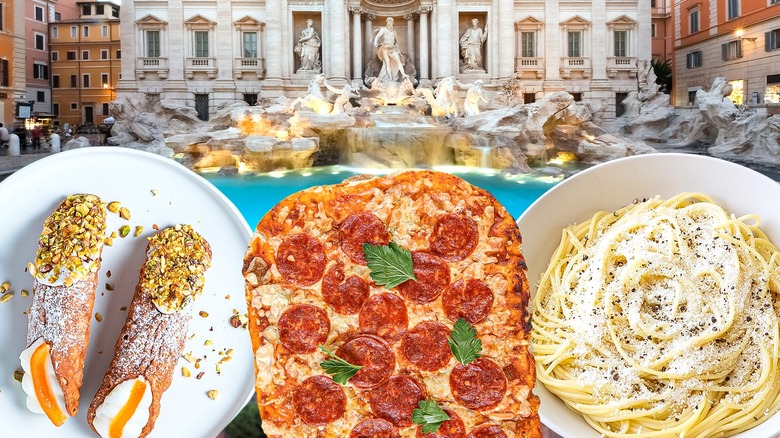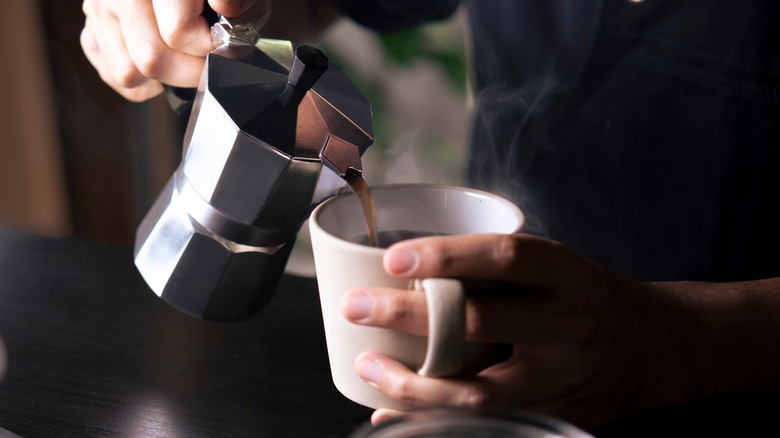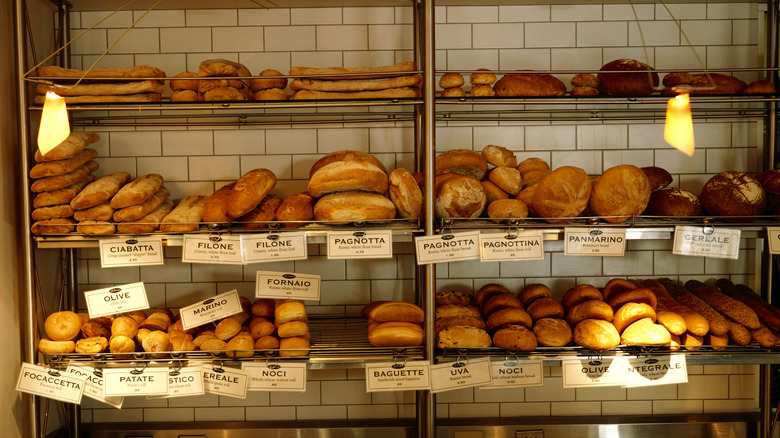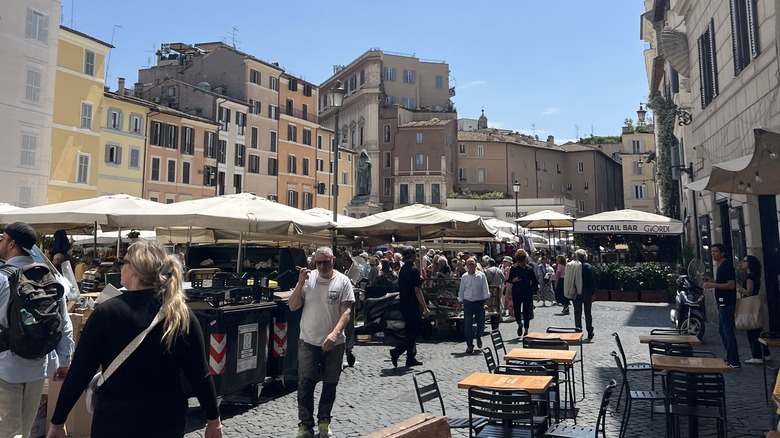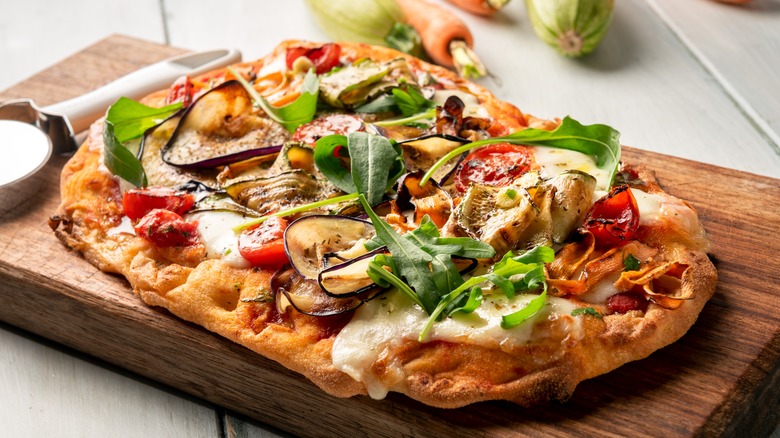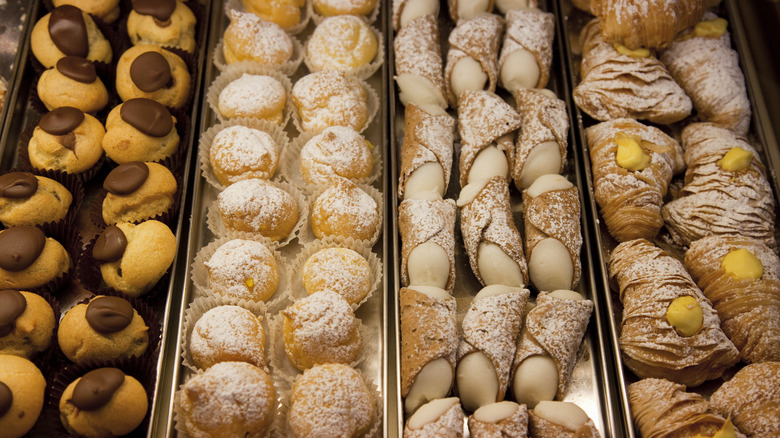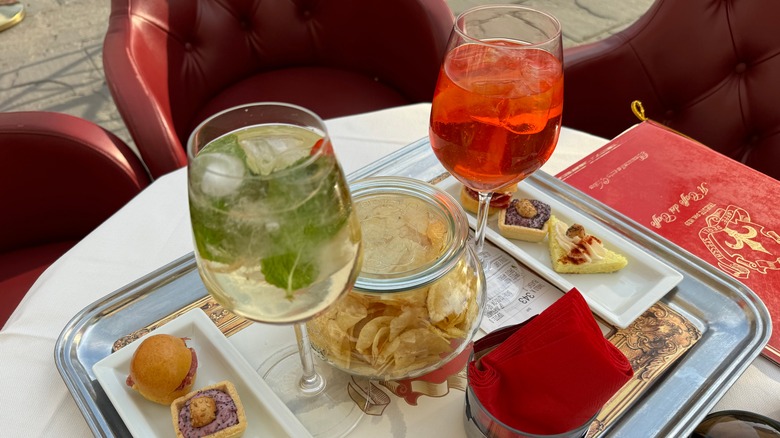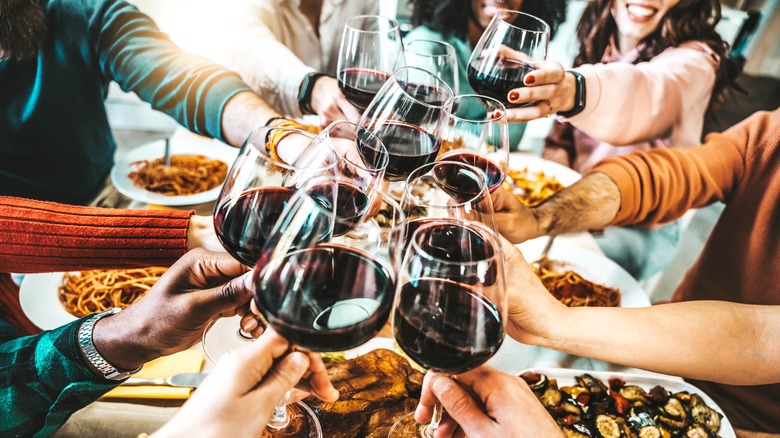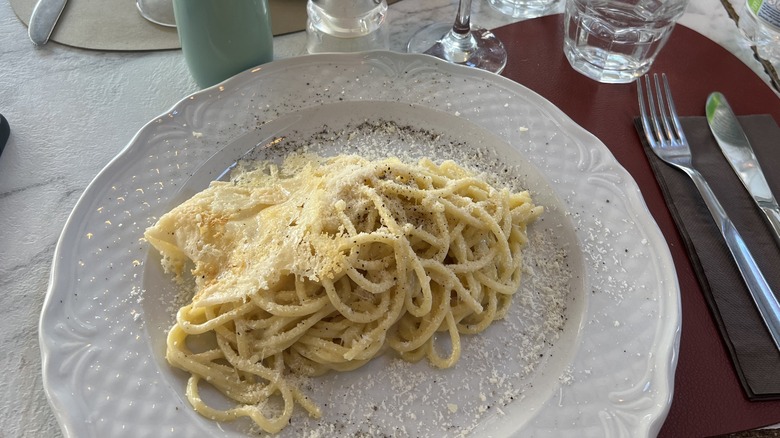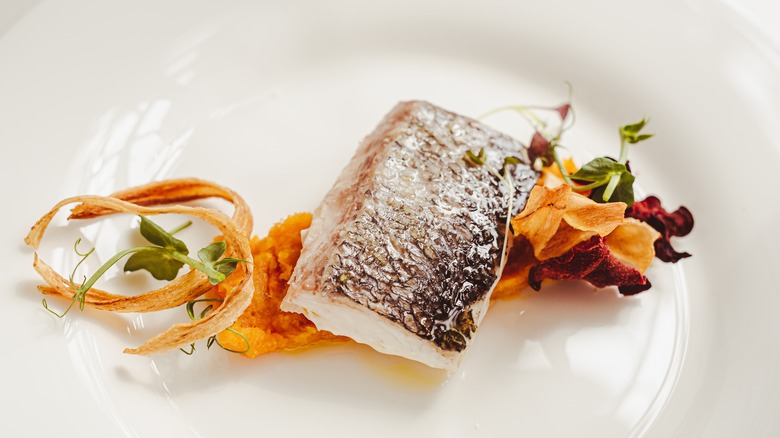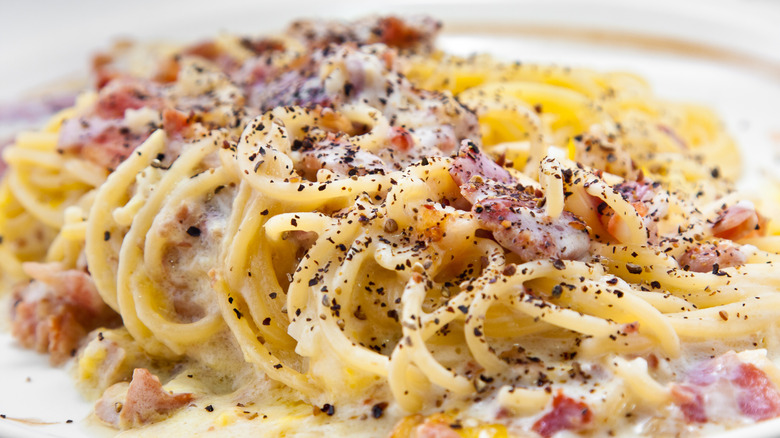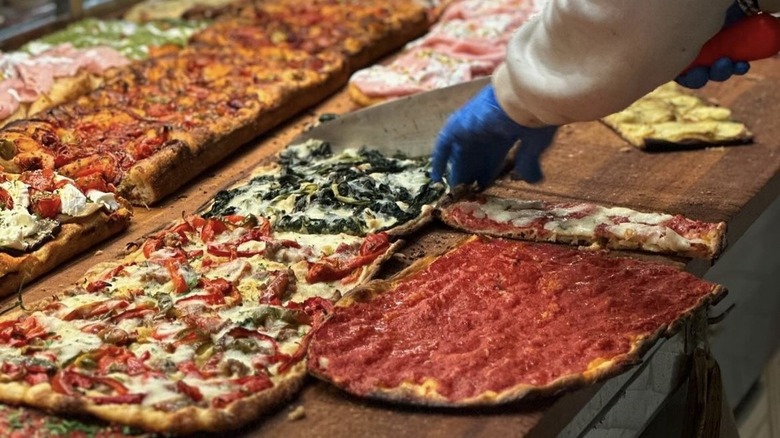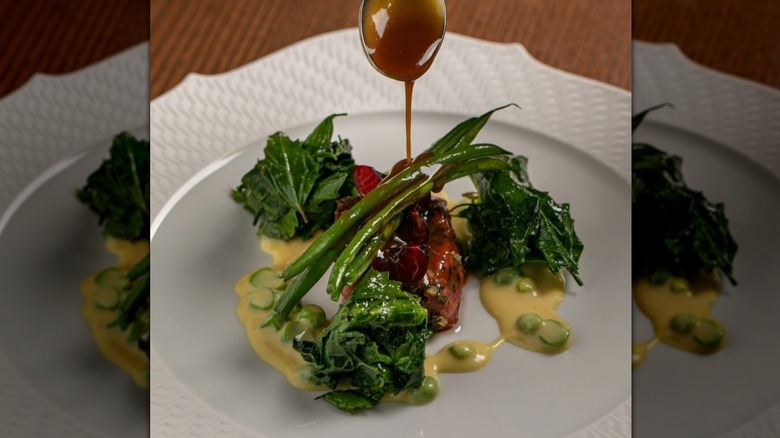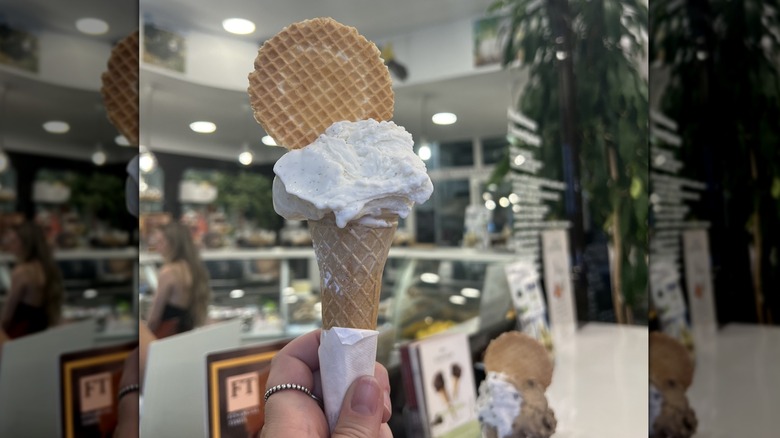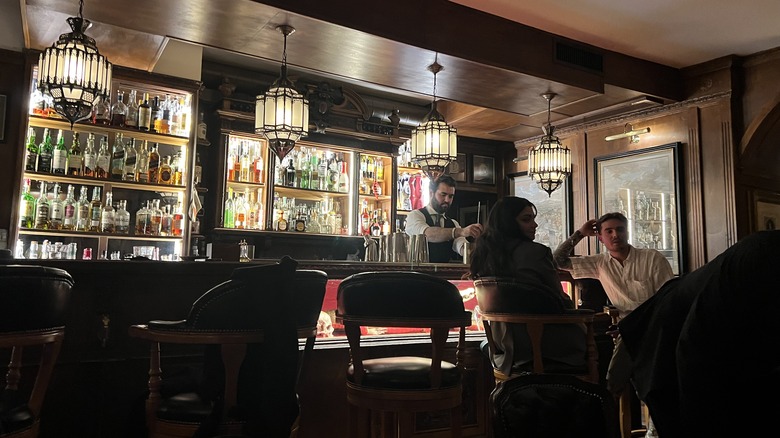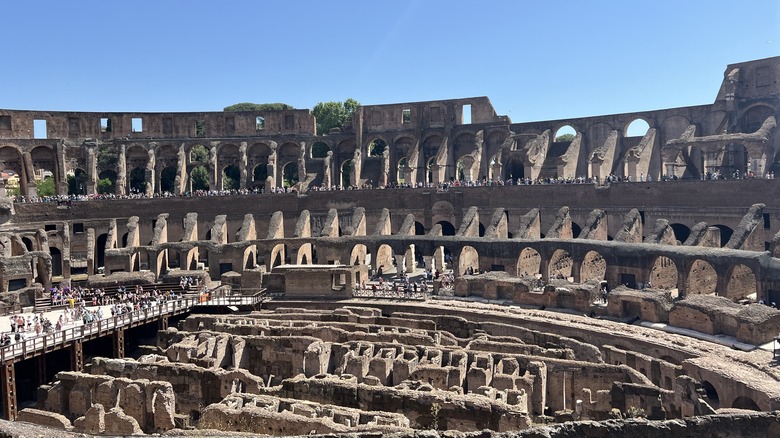What To Eat With Just 24 Hours In Rome
When in Rome, you should probably spend more than just 24 hours there to truly get the full experience. There's so much to see, from famous landmarks like the Colosseum and Trevi Fountain, to great shopping, and, of course, amazing food and drink. If you are just popping over for a day, there are several must-see, must-try foodie spots you simply can't miss.
After spending time in Rome this summer and reflecting on my personal experience — as well as consulting with friends and family who've spent months and years visiting and living in the Italian capital — I've come up with this comprehensive list of how you should plan your meals, snacks, drinks, and everything in between over the course of 24 hours. Obviously, in such an iconic and large city, there are going to be more local spots than I could possibly include here, and would take far more than a day to properly explore and dive into them. This is list of recommendations based on how much time you've got, realistically, starting in the morning and flowing from there.
Starting the day with Italian coffee
It's important to know that Italian coffee culture is vastly different than the United States'. Ordering a coffee (caffe) at most every place will get you an espresso, and unless you're in a very tourist-y place, requesting a "latte" might get you a confused look and a cup of milk. The structure and social aspect of coffee is different, too — if you're expecting to just get a cappuccino in a to-go cup and walk around the streets with it, you might be disappointed.
Instead, plan on sitting down for at least a few minutes and soak up your authentic coffee and take it all in. It's a great time to do some people-watching, too. If you are in a hurry, though, you can take your coffee "al banco," which just means you can stand up at the counter, drink it, and leave. It can also be slightly cheaper to order it that way if you're on a budget and looking to cut some costs.
Some solid spots to get coffee (or tea or hot chocolate) in Rome include Faro (located near the Villa Borghese park), Bar Santeo (near the Roman Forum), Antico Cafe Greco (very popular and opposite the Spanish Steps, but it can get crowded and touristy, so get there early), and Barnum Cafe (a few blocks away from the Piazza Navona).
Sample some freshly-baked bread
Once you've had your coffee, you need some more substantial fuel. Freshly-baked bread is, in my opinion, one of Rome's specialities and a great way to start off your day. There are bakeries on practically every block in Rome, and the majority of them are fantastic, so you really can't go wrong.
Any of the more savory bakery items would be my recommendation, as they'll probably fill you up for longer than a pastry would (besides, we're going to get to pastries in a bit). You could go for a whole loaf of your bread of choice, buy some butter or jam, and split it with your travel companions, or you could try some fresh homemade focaccia with different vegetables and herbs embedded in it. Some great bakeries for bread (and some offer great coffee, too) include Bakery M (located in a quiet, charming part of Rome across the river), Marigold Roma (also serving lots of other breakfast items), and Il Maritozzaro (famous for its maritozzi pastry, but all its offerings are delicious).
Hit the farmers market
Ready for a two-for-one combination of snack and activity? Next up on your agenda should be hitting one of Rome's farmers markets. My friends and I loved them so much we went multiple times on our trip. There are a few major ones throughout Rome, including one in Campo de Fiori, Mercato Trionfale just outside of Vatican City, and the Testaccio Market (which is more food-focused than anything).
The Campo de Fiori market in particular is a great place to shop for small, cheap souvenirs (think fridge magnets and pins) as well as food. The types of food here are pretty bountiful, including fruits and veggies, various jarred pasta sauces, jams, and even different drinks to try. It's also a fun spot to walk around and people watch. Just be prepared for some slight heckling from the different vendors trying to get you to buy their wares.
Lunch on some Roman pizza
It's time for lunch. You can't come to Rome without trying Roman pizza, and I think lunchtime is the perfect time to try it rather than dinner, when you should try all the fancy pasta dishes and wine pairings then (but more on that later). Roman pizza is its own unique style in that it is typically cut into square-shaped slices, made with copious amounts of olive oil, and is lighter than the greasy, heavy pizza you typically find in the United States.
Don't just walk into any pizza spot in Rome, though, as some shops do offer other styles of pizza. If you're interested in trying authentic Roman pizza (or even just good-quality pizza that isn't inherently traditional Roman-style), some research will help your tasting a lot. Pro Loco Pinciano, A Rota Pizzeria, and La Gatta Mangiona are all popular for a reason and offer very tasty pizza. Pizzeria Ostiense is also a common recommendation, though I will say only go out of your way to go there (in the Ostiense neighborhood) if you absolutely love very thin and very saucy pizza.
Grab some Italian sweets
You absolutely need to sample some sweet treats while you're in Rome for 24 hours; I don't make the rules. And since gelato is coming after dinner, now is the perfect time in your day for a classic Italian sweet like baba (rum cakes), zuppa Inglese (similar to a trifle), and bonet (like a boozy Italian chocolate pudding). Whether you go for a pastry like a cannoli, a dessert like tiramisu, or a classic Italian cake, you've got to get something in Rome (or maybe a few somethings and share them with friends and family).
For the pastry route, you need to check out Roscioli Caffè in the Regola area. It's one of the most popular bakeries in Rome, and for good reason. Amazing sweet pastries await you here, including cannolis, croissants, fruit tarts, maritozzi, cream puffs, and more. If you want to get a good look at what you're diving into, take a peek at Roscioli Caffè's Instagram and prepare to be blown away. If you want more of a sit-down vibe, Roscioli Salumeria con Cucina has a fantastic tiramisu, and so does Two Sizes (though Bar Pompi is the more famous spot to sample some tiramisu). Biscottificio Innocenti in Trastevere is a must-hit, too, for every pastry and cookie under the sun (you'll want to try them all).
Begin your evening with an aperitivo
Now that you've made it through the first half of your 24 hours, it's getting a little cooler outside, and you're approaching dinnertime. In Rome, though, nothing is to be rushed, and everything is to be savored. This includes the pre-dinner time. Begin your night with an aperitivo, as the Romans do.
An aperitivo, if you're unfamiliar, is considered an Italian restaurant course that comes before dinner. You can choose to have yours at the spot you're already going to have dinner at, or you could pop over to a different bar or restaurant just for the aperitivo and appetizer. An aperitivo is typically a light drink like a spritz that eases your way into the night. You could go for the classic Aperol spritz, but I'm partial to a Hugo spritz myself, which is an Italian cocktail you need to try and consists of St. Germain elderflower liqueur, Prosecco, mint, and soda water. It's the Aperol spritz's more laidback cousin.
Pair some good wine with dinner
After your relaxing and refreshing aperitivo, sit down at your selected restaurant (you've preferably made a reservation since most decent spots in Rome get pretty packed) and be very demure, very mindful about your drink order. If you're going the route of wine, try to have your wine pair nicely with your meal if you can. It's definitely worth trying out some glasses of DOC-certified Italian wine when in Rome.
Like reds? A delicious Italian wine variety that you might not have tried before is Barbera, which has low tannins and is quite common for Italians to drink since it's grown in Italy. Like whites? You could go for Frascati Superiore, which actually comes from the Lazio region, making it an easily-accessible and well-known wine variety in the city of Rome. There are actually a quite a few different wines that are specifically grown in Lazio, mostly whites, including Cannellino di Frascati (a sweeter white) and the specific bottle Colle Picchioni Donna Paolo Marino. Rosé lovers might be able to find the pink stuff at some restaurants, but it's generally not super popular in Rome.
Cacio e pepe is a great dinner choice
It should come as no surprise that there's no shortage of pasta in Rome. You could spend a week there sampling different dishes and riffs and not come close to trying them all. That means making the most of your 24 hours there is going to be tough. If you're not traveling solo, I recommend getting a few entrées and splitting them with your travel companions so you can all get a taste of everything.
Cacio e pepe is the first pasta dish you can't skip. It's one of the four traditional Roman pasta dishes, along with carbonara (more on that later), amatriciana (which is like a tomato sauce version of carbonara), and pasta alla Gricia (similar to cacio e pepe with less cheese and pepper and guanciale added). My personal favorite pasta dish, cacio e pepe done the right way is just Pecorino Romano cheese, pasta, and pepper. That's it. Since there are so few components, though, it can actually be easy to get the dish wrong if you use low-quality products. The tableside cacio e pepe at the Il Giardino restaurant in the Hotel Eden is renowned, but you can also find amazing cacio e pepe at Hosteria Grappolo D'Oro, Felice A Testaccio, and Ristorante Roma Sparita (where Anthony Bourdain famously loved the cacio e pepe).
But these fish dishes are solid options, too
While you're probably initially thinking about pasta and pizza when in Italy, it's also home to some succulent seafood, and Rome is no exception. Particularly the shellfish is solid, like oysters (which the Romans have been eating since the Roman Empire), clams in the form of spaghetti alle vongole, scallops, frittura di paranza (an appetizer that consists of fried squid, shrimp, and sometimes other fish), and crab, but there is some good white fish to be found in the city as well, like the elegant branzino or the popular baccala. The latter is salted cod that can be found prepared a number of ways, including fried, and is also sometimes available in markets as a quick meal, with the fried fish wrapped up and ready to eat.
If fish isn't your thing, I'd say it's okay to skip it in your short 24 hours in Rome, but if you're a seafood diehard, you can find some pretty tasty seafood throughout the city worth trying. There are actually quite a few seafood-centric restaurants in Rome, like La Pesceria Barberini and Acquasanta, that focus heavily on seafood and are known for their quality dishes.
You can't skip carbonara
We'll make this very simple: unless you have an allergy or particular aversion that prevents it, you absolutely need to try carbonara in Rome. It's the cornerstone of the four major Roman pasta dishes and arguably the very best in all of Italy. Even if you have had it before in the U.S. and didn't love it, the real stuff in Rome is good enough to change your mind. Carbonara should be made with homemade pasta (typically spaghetti), cured pork (traditionally guanciale, though pancetta is used sometimes, too), eggs, salt, pepper, and Pecorino Romano.
You'll find carbonara on most Italian restaurant menus, but I recommend trying it at places that specialize in pasta. A good carbonara should not taste eggy and runny, but rather salty and savory from the salt in the cheese and pork. Luciano Cucina Italiana dishes out some mouthwatering carbonara as does Trattoria Da Enzo al 29, a hotspot in Trastevere that serves it with paccheri (a large tubular pasta somewhat similar to rigatoni). Il Maritozzo Rosso, also in Trastevere, is well-known for its carbonara, too.
Eating in Rome with a budget
It is totally possible to ball on a budget in Rome, but you should do it with a plan. Otherwise, you might end up picking subpar spots where you don't love your entree and end up spending even more in snacks later to compensate for your subsequent hunger. You can find all the delicious foods you want in Rome for reasonable prices, including the aforementioned pasta dishes, but there are a few foods you can find especially cheap. Some include pastries and coffee, anything at the aforementioned farmer's market, sandwiches, suppli (fried rice and cheese balls), Roman pizza, and even pasta. You can find all of these items for fairly cheap wherever they're sold.
Some tasty budget-friendly restaurant suggestions you could try for dinner include Romolo e Remo, Da Gino al Parlamento, and Cesare al Pellegrino. They all have entrée options for under $22 that are delicious and memorable.
Higher end restaurants
If you're ready to absolutely ball out on food in Rome, boy oh boy are there so many restaurants you could splurge at. In my eyes, dinner would be the best meal to splurge on in Rome, as most breakfast spots are fairly cheap anyway. You could obviously go for any Michelin-starred restaurants (power to you) that serve Italian cuisine you have to try in Rome, but you could also go for one of these a little bit pricier restaurants people close to me have tried and loved.
Pierluigi is very seafood-focused, as is ilSanlorenzo Ristorante. Spazio Niko Romanito Roma's prices aren't outrageous, with entrées being around $33, but the atmosphere is modern and classy, giving it an elevated feel. Pulejo Ristorante offers a level up from Spazio, with entrees listed as low as $39 and as high as $67, and everything there is crafted with expertise and attention to detail. Enoteca la Torre, Acquolina Ristorante, Orma Roma, and Marco Martini are all Michelin-starred restaurants in Rome that are more than worth a visit if you can snag a reservation.
Gelato after dinner, of course
You didn't think I'd get through this whole article without talking about gelato, did you? Rome is famous for its bounty of longstanding, traditional gelaterias that have been in families for generations, churning out some unforgettable gelato.
Some tips for sussing out if the gelato shop you're going to walk into is legit or just a tourist trap: Number one, if it's proudly listed on the sign it's been open for more than 50 years, it's probably solid. Secondly, if you're looking at the case and the pistachio gelato is bright green, turn around and walk out the door. Real pistachio gelato should be super pale green, almost cream-colored, and anything with a bright hue means dyes have been added. Gunther Gelato in Rome is famous and totally delicious (pictured above), Gelateria Fassi is authentic and has been around since 1880, Ota Leg is modern and organic (and just as tasty), and Come il Latte is typically free from crowds of tourists as a hidden gem and you get to take your time selecting your gelato flavors and savoring them.
Bars and going out
After you've absolutely downed all of the good food, wine, and dessert you could possibly have, there's nothing left to do than go dance it off. Rome has some really memorable bars you need to check out, and there's truly something for everyone.
If you're a fan of a traditional nightclub and want to dance with your friends, you'll find a multitude of options in the Trastevere neighborhood. This neighborhood across the river is tucked away from most of the tourist attractions, and the whole thing is covered with lots of fun nightlife spots like Bar San Calisto (one of the most popular spots there), Ma Che Siete Venuti a Fa' (a great spot for quality beer), Delirium Cafe Roma (touts itself as the best beer cafe in the world), and Mr. Brown Trastevere (a gem of a dive bar with fun cocktails). You could spend your night popping from bar to bar over a few blocks, trying a bit of everything. If you want less of an overstimulating experience, I could not recommend Wisdomless more. My friends and I had a wonderful experience at this unique bar, and I had the best French 75 I've ever tasted there. It can be a bit difficult to get in, so either prepare for a wait or make a reservation online. The atmosphere is dark and moody, the bartenders are at the top of their game, and you can even get tattoos there in the back.
How I selected what to eat in with just 24 hours in Rome
This list of foods, drinks, and places is based on my personal experience visiting Rome this summer. I also received some serious recommendations from multiple friends and family members that have spent extensive time there, including semesters abroad, and additional online research to fill in the gaps and make sure I didn't miss any key spots.
There are obviously lots more amazing restaurants and places to eat in Rome than are included in this piece, but this isn't intended to be an extensive list. Rather, this is a rough guide to how to prioritize different types of food to eat in Rome and hit all the must-try items with limited time in the Italian capital.
